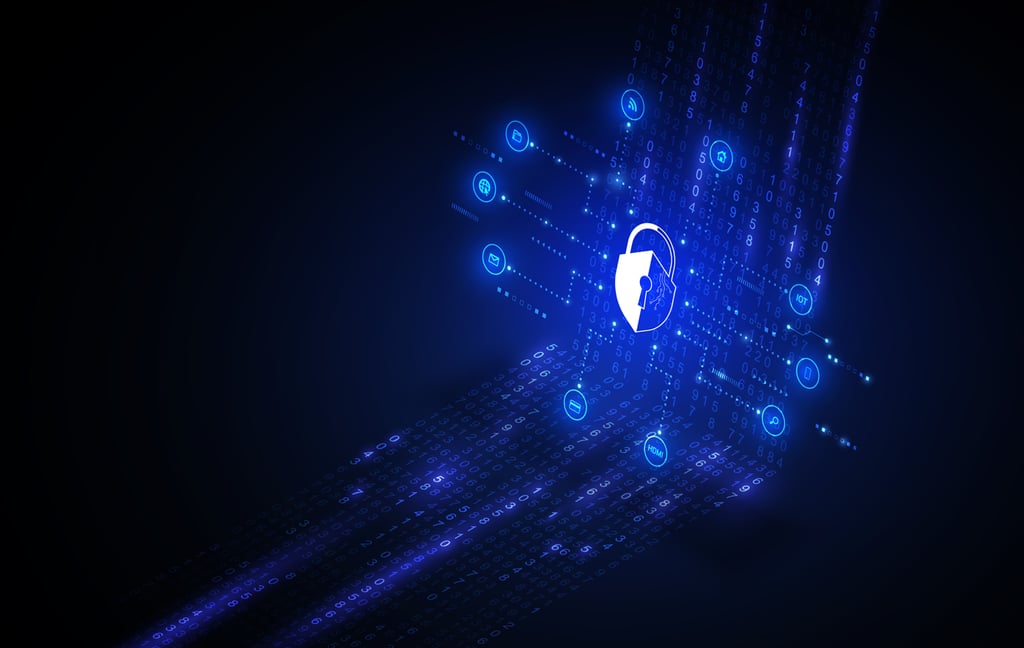

Lock icon connected to different icons related to aspects of cybersecurity in a digital environment.
Protect your computer and data from hackers and malicious software with the help of a firewall. Here’s a step-by-step guide to setting up a firewall.


Firewalls are essential to any robust cybersecurity strategy as they help organizations control inbound and outbound traffic, monitor for malicious activities, and protect their systems against unauthorized access.
However, setting up a firewall can be daunting for many organizations as the constantly evolving cybersecurity landscape often leaves them unsure of where to begin.
In this guide, we’ll unravel how to set up a firewall and some critical factors to consider while doing so.
Configuring a firewall involves various components—from hardware and software to documentation and rules—that work together to create a robust security posture.
The hardware component of a firewall refers to the physical device responsible for filtering network traffic. It typically includes specialized processors, memory, ports, and network interfaces.
Firewall hardware can range from standalone appliances to integrated devices such as routers and switches with built-in firewall capabilities. Sorting out the right hardware is crucial, as it determines factors like performance, scalability, and additional features.
Vendors like Cisco, Juniper, and Fortinet provide reliable and robust firewall solutions.
Firewall software comprises the operating system (OS) and associated applications installed on (or acting in place of) the firewall hardware. It provides the necessary tools and interfaces to configure and manage the firewall.
The software enables administrators to define firewall rules, access control policies, and manage other security parameters.
You’ll need an OS on which the firewall software can run, especially if you use a software-based firewall. This could be a general-purpose operating system like Linux or a specialized firewall-focused one like pfSense or Cisco.
Network interfaces facilitate the firewall’s connection to your network and enable network traffic monitoring. They can be integrated into the firewall hardware or on the server running the firewall software.
The number of interfaces needed will depend on your network architecture and the level of segmentation and control you aim to achieve.
You must define firewall rules that specify what traffic should be allowed or blocked. This involves understanding your network’s security needs and developing well-designed rule sets that effectively enforce policies such as default deny, allowlisting and blocklisting, content filtering, intrusion prevention, and VPN enforcement.
A network diagram outlining your network infrastructure is crucial for understanding your network’s layout, identifying potential security risks and conducting an effective firewall audit. It visually represents how different components are connected, helping you design and implement effective firewall rules.
It is also essential to document the configuration and rules of your firewall. This helps to understand the firewall’s setup and allows for easier troubleshooting and maintenance.
Configuring a firewall involves several steps to ensure its proper setup and functionality, from initial securing to testing. Here are the steps typically involved in the firewall configuration process.
Securing a firewall ensures that only authorized administrators can access it. This involves several elements:
To protect network assets and resources, it is essential to identify them and establish a structured approach. This involves grouping corporate assets into zones based on their functions and the level of risk they pose.
An excellent illustration of this practice is segregating servers, such as email, VPN, and web servers, into a dedicated demilitarized zone (DMZ). The DMZ limits inbound internet traffic, bolstering security measures. Creating multiple zones within the network enhances network security, allowing for better traffic control and management.
Once a network zone structure is established, aligning it with an appropriate IP address structure is crucial. This ensures that zones are correctly assigned to firewall interfaces and subinterfaces, enabling effective traffic monitoring and control.
ACLs play a vital role in network security by enabling organizations to regulate traffic flow between zones. ACLs should be configured with precision, specifying source and destination port numbers and IP addresses. Implementing a “deny all” rule at the end of each ACL ensures that unauthorized traffic is filtered out.
Furthermore, each interface and subinterface should have inbound and outbound ACLs to authorize only approved traffic. To safeguard configuration and prevent unauthorized access, it is recommended to restrict public access to firewall administration interfaces and turn off unencrypted firewall management protocols.
Firewalls can be configured to accommodate additional services, including:
Conduct thorough testing to verify that the firewall functions as intended. Testing helps identify any vulnerabilities or misconfigurations that may expose your system to potential threats.
The firewall setup testing can include things like network segmentation controls, rule verification, and logging and monitoring review.
When setting up a firewall, there are several important factors to watch out for to ensure adequate network security, including your firewall type, logging and monitoring systems, and implementing a disaster recovery plan.
Choose the appropriate type of firewall based on your network requirements. Common types include packet-filtering firewalls, stateful inspection firewalls, and proxies with advanced features like intrusion detection and prevention.
Configure firewall logging to capture comprehensive data on network traffic and connection attempts. Also, establish a centralized logging system to gather and examine the firewall logs effectively.
Implement robust authentication mechanisms and restrict administrative access to authorized personnel only.
In the event of a firewall failure or misconfiguration, it’s important to have a disaster recovery plan in place. Regularly back up your firewall configurations and ensure you have a documented procedure for restoring the firewall to a functional state.
Regularly review and update access control lists and user privileges to maintain security. Also, stay updated with the latest firmware, software patches, and security updates the firewall vendor provides. This addresses any newly discovered vulnerabilities and reduces the risk of unauthorized access or exploitation.
Firewalls are essential in securing and protecting your network from unauthorized access and potential threats. Following the steps to firewall configuration outlined in this guide, you can establish a robust defense mechanism for your system and safeguard sensitive data, preserve network privacy, and reduce potential risks, ultimately ensuring a secure and resilient network environment for your organization.
Once your firewall is all set up, don’t forget to perform regular firewall audits.
If you’re still deciding on a firewall, we compiled a list of the best enterprise firewalls, as well as the best firewalls for small and medium businesses.


Franklin Okeke is a contributing writer to Enterprise Networking Planet, as well as an author and freelance content writer with over 5 years of experience covering cybersecurity, artificial intelligence, and emerging technologies. In addition to pursuing a Master's degree in Cybersecurity & Human Factors from Bournemouth University, Franklin is an entrepreneur with a passion for startups, innovation, and product development. His writing also appears regularly in TechRepublic, ServerWatch, and other leading technology publications.

Enterprise Networking Planet aims to educate and assist IT administrators in building strong network infrastructures for their enterprise companies. Enterprise Networking Planet contributors write about relevant and useful topics on the cutting edge of enterprise networking based on years of personal experience in the field.
Property of TechnologyAdvice. © 2025 TechnologyAdvice. All Rights Reserved
Advertiser Disclosure: Some of the products that appear on this site are from companies from which TechnologyAdvice receives compensation. This compensation may impact how and where products appear on this site including, for example, the order in which they appear. TechnologyAdvice does not include all companies or all types of products available in the marketplace.